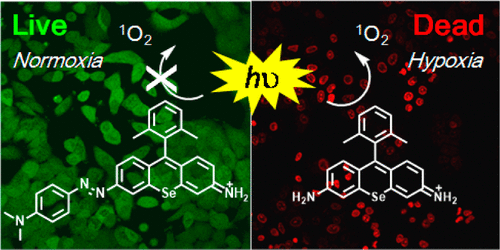当前位置:
X-MOL 学术
›
J. Am. Chem. Soc.
›
论文详情
Our official English website, www.x-mol.net, welcomes your feedback! (Note: you will need to create a separate account there.)
Development of an Azo-Based Photosensitizer Activated under Mild Hypoxia for Photodynamic Therapy
Journal of the American Chemical Society ( IF 15.0 ) Pub Date : 2017-09-25 00:00:00 , DOI: 10.1021/jacs.7b05019 Wen Piao 1 , Kenjiro Hanaoka 1 , Tomotsumi Fujisawa 2 , Satoshi Takeuchi 2, 3 , Toru Komatsu 1, 4 , Tasuku Ueno 1 , Takuya Terai 1 , Tahei Tahara 2, 3 , Tetsuo Nagano 5 , Yasuteru Urano 1, 6, 7
Journal of the American Chemical Society ( IF 15.0 ) Pub Date : 2017-09-25 00:00:00 , DOI: 10.1021/jacs.7b05019 Wen Piao 1 , Kenjiro Hanaoka 1 , Tomotsumi Fujisawa 2 , Satoshi Takeuchi 2, 3 , Toru Komatsu 1, 4 , Tasuku Ueno 1 , Takuya Terai 1 , Tahei Tahara 2, 3 , Tetsuo Nagano 5 , Yasuteru Urano 1, 6, 7
Affiliation

|
Photodynamic therapy (PDT) utilizes photoirradiation in the presence of photosensitizers to ablate cancer cells via generation of singlet oxygen (1O2), but it is important to minimize concomitant injury to normal tissues. One approach for achieving this is to use activatable photosensitizers that can generate 1O2 only under specific conditions. Here, we report a novel photosensitizer that is selectively activated under hypoxia, a common condition in solid tumors. We found that introducing an azo moiety into the conjugated system of a seleno-rosamine dye effectively hinders the intersystem crossing process that leads to 1O2 generation. We show that the azo group is reductively cleaved in cells under hypoxia, enabling production of 1O2 to occur. In PDT in vitro, cells under mild hypoxia, within the range typically found in solid tumors (up to about 5% O2), were selectively ablated, leaving adjacent normoxic cells intact. This simple and practical azo-based strategy should be widely applicable to design a range of activatable photosensitizers.
中文翻译:

在轻度缺氧条件下活化的基于偶氮的光敏剂的开发,用于光动力疗法
光动力疗法(PDT)在存在光敏剂的情况下利用光照射通过产生单线态氧(1 O 2)消融癌细胞,但是将对正常组织的伴随伤害降至最低是很重要的。实现此目的的一种方法是使用仅在特定条件下才能生成1 O 2的可活化光敏剂。在这里,我们报告了一种新型的光敏剂,它在缺氧的情况下被选择性激活,缺氧是实体瘤的常见情况。我们发现,将偶氮部分引入硒代罗莎明染料的共轭体系中会有效地阻碍导致1 O 2的体系间交叉过程一代。我们显示,在缺氧条件下,偶氮基团在细胞中被还原性裂解,从而使1 O 2的产生发生。在体外PDT中,有选择地消融轻度缺氧条件下的细胞,该条件处于实体瘤中通常存在的范围内(最多约5%O 2),而相邻的常氧细胞则保持完整。这种简单且实用的基于偶氮的策略应可广泛应用于设计一系列可活化的光敏剂。
更新日期:2017-09-26
中文翻译:

在轻度缺氧条件下活化的基于偶氮的光敏剂的开发,用于光动力疗法
光动力疗法(PDT)在存在光敏剂的情况下利用光照射通过产生单线态氧(1 O 2)消融癌细胞,但是将对正常组织的伴随伤害降至最低是很重要的。实现此目的的一种方法是使用仅在特定条件下才能生成1 O 2的可活化光敏剂。在这里,我们报告了一种新型的光敏剂,它在缺氧的情况下被选择性激活,缺氧是实体瘤的常见情况。我们发现,将偶氮部分引入硒代罗莎明染料的共轭体系中会有效地阻碍导致1 O 2的体系间交叉过程一代。我们显示,在缺氧条件下,偶氮基团在细胞中被还原性裂解,从而使1 O 2的产生发生。在体外PDT中,有选择地消融轻度缺氧条件下的细胞,该条件处于实体瘤中通常存在的范围内(最多约5%O 2),而相邻的常氧细胞则保持完整。这种简单且实用的基于偶氮的策略应可广泛应用于设计一系列可活化的光敏剂。



























 京公网安备 11010802027423号
京公网安备 11010802027423号